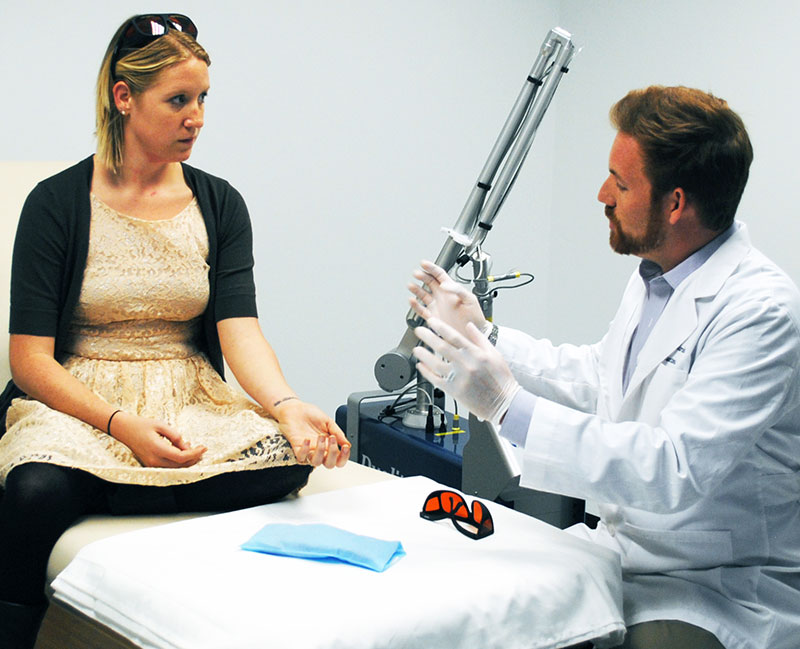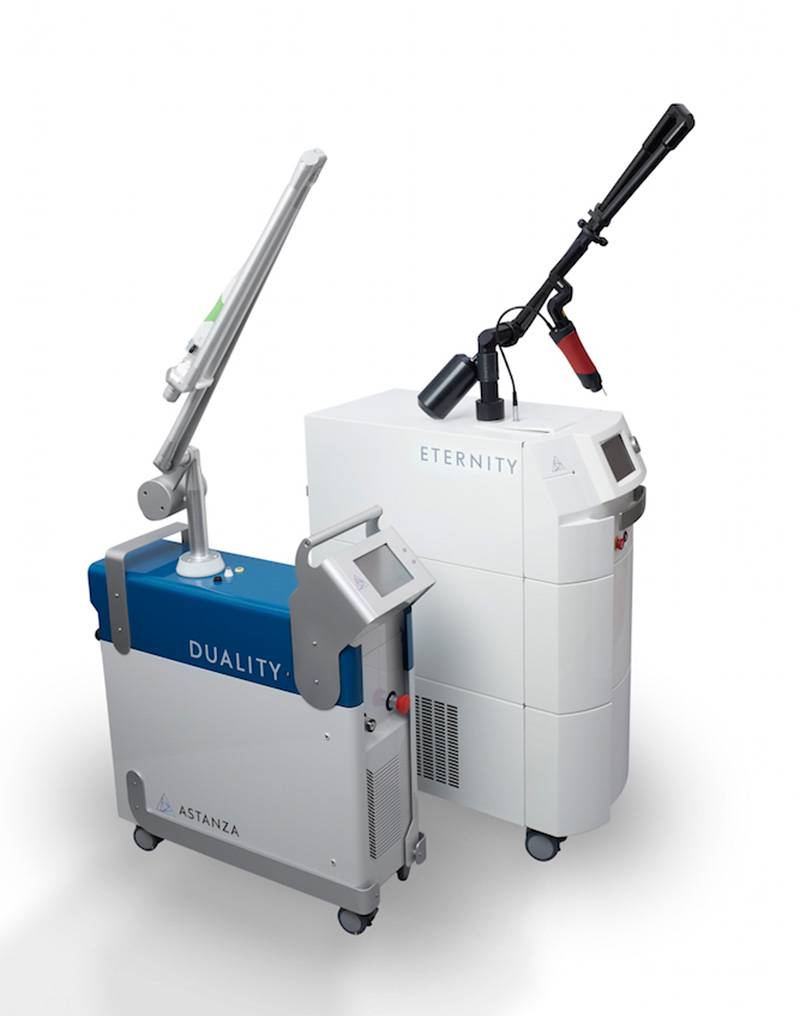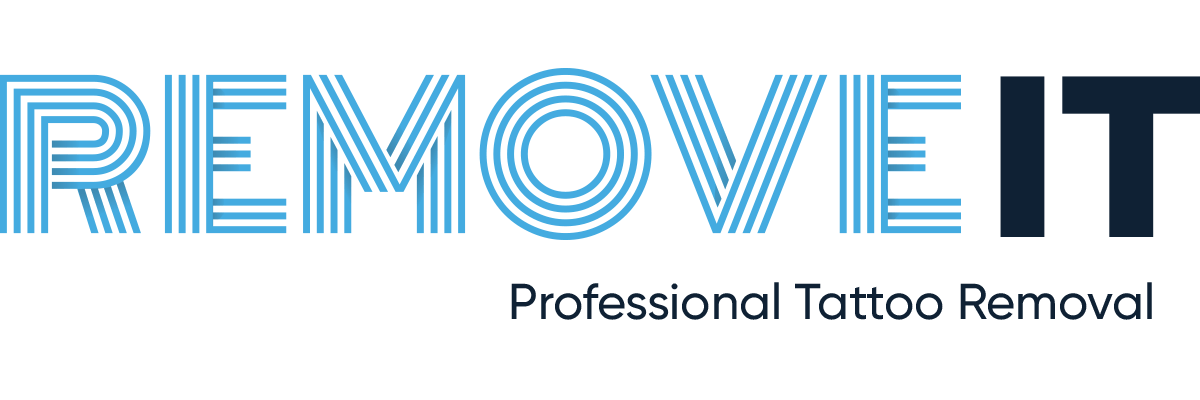How tattoo removal & fading works.
Tattoo removal works by breaking apart larger ink particles layer by layer. Then, your body’s immune system cells carry away the smaller, broken-down particles of ink.
There is no damage to the skin with treatment as the laser only targets the pigment. With time and continued sessions, a tattoo can be completely removed.


Our Process
Learn what factors go into removing and fading tattoos, what typical timelines are, and the importance of pre-care and after-care. See why Remove It is hands down the #1 choice for tattoo removal and fading.


Our Technology
The Trinity laser treatment machine is the ideal choice for elite practices that want superior technology to treat colorful inks, including resistant shades of blue and green. The Trinity was designed to get the job done in twice the amount of power with twice the number of lasers.

Frequently Asked Questions
General Tattoo Removal Questions
Can lasers remove tattoos completely?
Yes, lasers can remove tattoos altogether. Lasers are the safest and most effective tool to remove unwanted tattoos. However, you will likely need multiple sessions before the tattoo is entirely removed. Even then, not all tattoos are 100% removable. The number of sessions depends on the size, age, location, and color of the tattoo you want to remove.
Can I get a brand new tattoo removed?
It depends. Some people have the regret of a tattoo before they even hit the parking lot on the way home from the tattooist. But the last thing you want to do is expose an irritated and exposed area of skin to the powerful light of a laser tattoo removal procedure. You should wait about three months after a tattoo is complete before can removal begin.
What is the lymphatic system?
Your lymphatic system is part of your body's immune system. Organs such as your tonsils, spleen (yes that's a real thing), lymph nodes, lymphatic fluid, and lymphatic ducts, among other things, aid in the fight against infection. Most importantly, the lymphatic system produces and releases lymphocytes or White Blood Cells (WBCs). This is why when you have a cold or flu, you often have swollen lymph nodes in your neck that accompany your sore throat. Another function of the lymph system is to flush out potentially harmful substances, like toxins, out of the body. Your body is encouraged to ramp up your lymphatic system when a laser breaks down tattoo ink or benign hyperpigmentation (think port wine stains) into tiny manageable pieces.
Questions About Our Process
Will this treatment method remove my tattoo effectively?
As with any treatment method, the efficacy of laser tattoo removal depends on circumstances unique to you. However, we will tailor a treatment plan that will work for you.
Remember, the number of sessions you need to eradicate your tattoo depends on several factors, including the tattoo's color, density, and size. Nonetheless, even if one session will not remove the unwanted tattoo, your lymphatic system gets to work immediately, flushing away the broken-down pigments. Ergo, after your first session, you will see an improvement in just a few short weeks.
How many sessions will I need to achieve my desired results?
We can give you a good idea of how many sessions you will need to remove your unwanted tattoo entirely during your initial consultation. Remove It cannot in good conscience guarantee that every tattoo will achieve a 100% removed result. The average tattoo can be removed within five and eight laser sessions. Dark or black tattoos that have been around for a decade or two may only require three or four removal sessions. New, dense, fluorescent tattoos may take 10 or more treatment sessions before full or near-full removal is possible.
What do I need to do before I show up for my first treatment?
The preparation for laser treatment is relatively straightforward.
- Be excited. You are taking the first step to becoming the person you really want to be. At RemoveIt, we feel that the laser treatment is only a portion of the process of removal or fading. You got to this point on purpose. You should be proud of yourself.
- Know your medical history, and the medications you are taking. The laser technician or nurse will ask you about your medical history to make sure the procedure remains safe for you. For instance, antibiotics can help you fight infection but more than likely will make your skin more photosensitive or hypersensitive to light. Meaning, your skin will absorb more of the laser’s powerful light through the melenin in your skin and could cause serious side effects. Wait until you are off of your antibiotics for at least two weeks before coming in for your first or subsequent treatments.
- Avoid sun exposure. You will find that for most skin types, sun exposure will be the main problem that increases your risk for complications (eg, blistering, dyspigmentation, and scarring). This applies to tanning beds, artificial tanning, tanning creams or any other additional layer between your natural skin and the laser’s light source. Use a mineral type, zinc based sunscreen on your skin for best sun protection and it is an overall healthier sunscreen product. RemoveIt stocks many options for sunscreen available for aftercare.
- Understand the risks associated with laser tattoo removal. The most common adverse effects of Q-switched laser treatments include blister formation, bleeding, infection, and scarring. While some of these adverse effects are very normal, such as blister formation, you should be aware of the potiential issues associated with ALL laser tattoo removal procedures. These side effects are not specific to RemoveIt but to all providers of laser tattoo removal procedures. RemoveIt will be here to ensure your risk for adverse effects are minimal.
Technology Questions
How do lasers remove or fade a tattoo?
Tattooing is using a needle to embed ink deep under the skin's surface. After the tattooist deposits the ink under the skin, the body's natural immune response holds the tattoo in place. The molecules of the ink are too large for the body's white blood cells (WBCs) to carry away the ink through the lymphatic system to the liver. A certified professional using a quality FDA-approved laser breaks up those large particles into smaller pieces that the body can remove naturally over time. The key takeaway is that different color ink absorbs the frequency of a laser differently, so the color, age, and type of tattoo are essential to know.
We want to reiterate that there is no safer or more effective way to eliminate or fade unwanted tattoos than laser treatments. Lasers have been effectively used to remove and fade unwanted tattoos for decades with excellent results.
What colors can a laser remove from the skin?
The laser affects different colors in different ways. Brighter ink will reflect more of the laser's light. So, if your tattoo is mainly bright colors, you will need more removal sessions than you would if you had a dark tattoo that absorbed more of the laser light beam.
Tattoo lasers, what is best?
There are choices when deciding to remove or fade an unwanted tattoo. Out of 397 patients studied with Q-switched lasers and a minimum treatment interval of six weeks, successful removal of the tattoo occurred in 47.2 percent (95% CI, 41.8- 52.5 percent) of patients after 10 sessions and 74.8 percent (95% CI, 68.9-80.7 percent) of patients after 15 sessions. Below are some versions of tattoo removal laser technology:
- Q-Switched (Quality-Switched) – Nanosecond Lasers
- Nd:YAG laser (Neodymium Doped: Yytrium Aluminum Garnett)
- Ruby laser
- Alexandrite laser
PICO Lasers – Picosecond lasers are a relatively new FDA-approved laser that has been used for about a decade with mixed results. Marketing and sales tactics selling picosecond lasers drove up prices and did not deliver on their promises. These lack of results has recently led to class action lawsuits against one of the leading PICO laser manufacturers, citing false advertising and lack of results leading to poor client outcomes. I recommend clients avoid these types of lasers until results are proven. Below are the four leading pico lasers on the market.
- PicoWay
- PicoSure
- PicoPlus
- PicoCare
RemoveIt uses an industry leading Q-switch Nd:YAG nanosecond laser with three different wavelengths. This versatility can remove all colors of tattoo ink, with some being easier than others.


